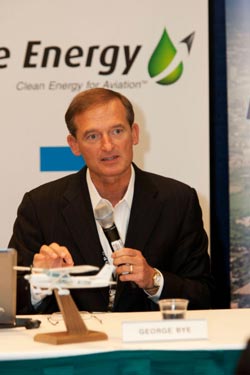Cessna, Bye Energy commit to electric Cessna 172
 At a press conference at AOPA Aviation Summit, Cessna and Bye Energy announced significant progress on a joint project to retrofit Cessna 172s with 210-horsepower electric powerplants. Though it’s being called a technology demonstrator, the two companies sounded very much committed to bringing their “Green Flight Project” airplane to the market. For example, the first demonstrator’s schedule has the airplane making its first flight in the spring of 2011.
At a press conference at AOPA Aviation Summit, Cessna and Bye Energy announced significant progress on a joint project to retrofit Cessna 172s with 210-horsepower electric powerplants. Though it’s being called a technology demonstrator, the two companies sounded very much committed to bringing their “Green Flight Project” airplane to the market. For example, the first demonstrator’s schedule has the airplane making its first flight in the spring of 2011.
The airplanes will be powered by an electric motor manufactured by Bye Energy, and an optional, 40-hp Jet A-powered auxiliary power unit. The first airplane will have a two-blade composite propeller, but plans are to make a switch to a six-blade propeller on the first supplemental type certificated variants. Charles Johnson, COO of Bye Energy, said that the first electric Cessna 172s would match the performance of conventional, piston-powered 172s, and that its weight and balance profiles would not change “one bit.” He also said that gross weight would be the “same or lower” than a conventional Skyhawk. Of particular interest is the fact that the electric motor’s power will not fall off with altitude—because it does not require air to generate power.
While the lithium-ion batteries that power the Green 172 will weigh between 650 and 700 pounds, “there’s a lot of weight that we can take out of the Skyhawk to accommodate them,” Bye said. For example, removing the Lycoming engine (about 400 pounds), plus the Skyhawk’s avgas and fuel tanks (about 300 pounds) easily allow for battery installation without penalty. In addition, solar panels will be fitted to the upper wing surfaces. These will allow discharged batteries to fully charge in two to four days in remote locations where AC power is not available. As for more typical charging situations, Johnson said that it would take about two hours to completely recharge the batteries; this charge would then allow approximately two hours of flight.
The Green 172 offers aerodynamic and cost savings. Without the need for engine cooling inlets, cooling drag is reduced. In all, parasite drag is reduced by 10 to 14 percent. In addition, small rotors are affixed to the trailing edges of the airplane’s wingtips. These capture the energy from wingtip vortices and, like the wing-mounted solar panels, send it to the batteries as the airplane flies. Other aerodynamic efficiencies come from a wider propeller chord at the blade root.
The Bye electric motor is anticipated to have a useful lifetime of 20,000 to 30,000 hours, and the engine has but two moving parts. In all, Bye calculates a halving of operating costs compared to those of a standard 172: $10 per hour versus $55 per hour. As for the projected cost of the retrofit, Cessna and Bye mentioned a “parity” with the cost of a new Cessna Skyhawk.
Why pursue the 172? Bye cited his focus on a mainstream airplane that has a large role in pilot training. Will the Green 172 ever progress beyond a retrofit status to being a certified FAR Part 23 airplane, manufactured by Cessna? “A type certificate may well be in this airplane’s future,” said a Cessna spokesman.— Thomas A. Horne



